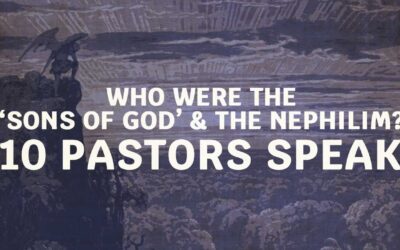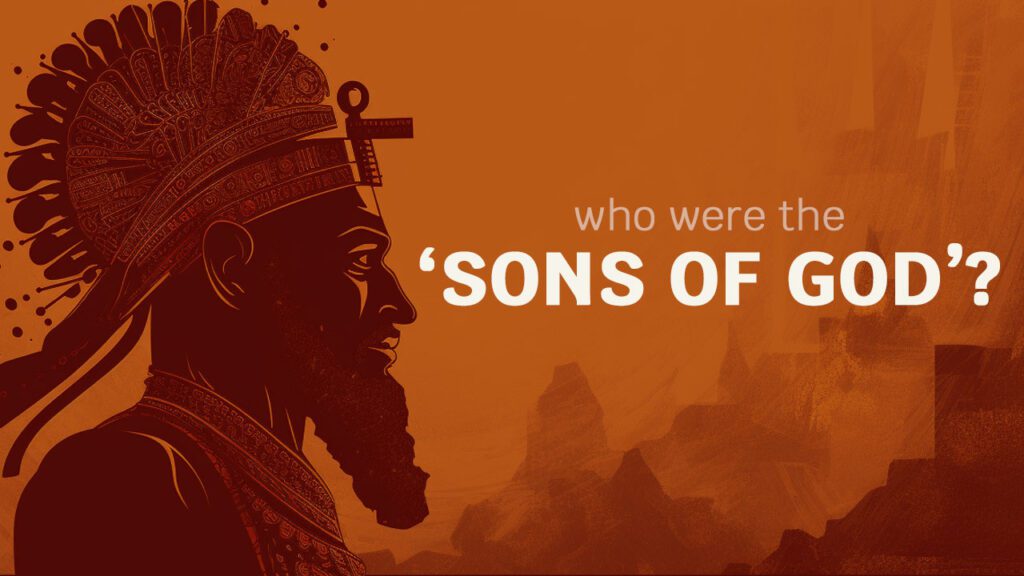
Everything you need to know about the historical, textual and theological evidence pointing to the true identify of the ‘sons of God’ in Genesis 6.
The enigmatic “sons of God” in Genesis 6 have been the subject of much debate and speculation for centuries.
When man began to multiply on the face of the land and daughters were born to them, the sons of God saw that the daughters of man were attractive.
Genesis 6: 1 – 4 (ESV)
And they took as their wives any they chose.
Then the LORD said, “My Spirit shall not abide in man forever, for he is flesh: his days shall be 120 years.”
The Nephilim were on the earth in those days, and also afterward, when the sons of God came in to the daughters of man and they bore children to them.
These were the mighty men who were of old, the men of renown.
Although numerous theories exist, a comprehensive understanding of who they were and what they did remains elusive. Despite the vast amount of information available online, their quality and reliability vary widely, leading to conflicting viewpoints and competing agendas.
As someone who has dedicated two decades to studying this topic, I have gained a measure of insight into the nuances of the debate, yet have also become increasingly aware of the gaps in our (my) knowledge.
However, by drawing from scholars and theologians who have explored this topic over the last 2,000 years, I will endeavor to provide one of the most comprehensive resources available in this article. Together, we may come to a more complete understanding of this enigmatic subject.
What does ‘Sons of God’ mean?

The term “sons of God” holds great significance and a lot hinges on making sure we understand the term and its original usage. Before delving into the popular interpretations and the arguments surrounding them, it is important to take a closer look at the words themselves and how they are employed in the Bible.
The Textual Context for the ‘Sons of God’ in Genesis 6
The opening chapters of Genesis are foundational to understanding the biblical narrative of creation, fall, and redemption. The first humans, Adam and Eve, were created in God’s image and given dominion over the earth, but they rebelled against God and were expelled from the Garden of Eden. From there, the human story unfolds, with both triumphs and tragedies, culminating in the coming of the Messiah, Jesus Christ.
The passage in question, Genesis 6:1-4, occurs after the expulsion from Eden and after the account of Cain and Abel, and it sets the stage for the story of Noah and the Flood.
The chapter begins by saying that mankind was growing more numerous and that ‘the sons of God’ noticed how attractive the young women were.
When man began to multiply on the face of the land and daughters were born to them, the sons of God saw that the daughters of man were attractive. And they took as their wives any they chose.
Genesis 6: 1-2 (ESV)
We’re told this without any further elaboration on the identity of these ‘sons’ from the author, just like there was no elaboration on the identity of the serpent just a few chapters prior. The author doesn’t seem to think any further identification is required for his readers to understand him.
The identity of ‘man’ and their ‘daughters’ seems clear to us today. No particular group is being singled out that these daughters came from. And again, the author finds no need to qualify the statement further. The real question is regarding ‘the sons of God’, which we will explore below.
These ‘sons of God’ found these women attractive and intentionally took wives from among the ‘daughters of man’, and seemed to do so with impunity. They took ‘any they chose’!
However it happened, I imagine it looked pretty close to this classic movie scene:
Then the LORD said, “My Spirit shall not abide in man forever, for he is flesh: his days shall be 120 years.”
Genesis 6
God responds and utters a proclamation that there would be some kind of time limit of 120 years.
Some wonder if that meant 120 years before the flood would come, or that humans would live shorter lives, since they were able to achieve so much wickedness in the longer lives Genesis records for early mankind.
Although this is an interesting question and is also debated by theologians, that isn’t the question we’re exploring in this article, so let’s move on.
The Nephilim were on the earth in those days, and also afterward, when the sons of God came in to the daughters of man and they bore children to them.
Genesis 6
The text introduces the Nephilim (‘giants’ in some translations), which now raises questions who they are, just as it does for the ‘sons of God.’
But before we can understand this new mystery, it is necessary to have some understanding of the ‘sons of God’ to understand their connection and relationship with the Nephilim.
While there is debate about on this, most agree that there is a link between the actions of the ‘sons of God’ and the emergence of the Nephilim. The common interpretation being that the nephilim were the offspring of the ‘sons of God’ and the ‘daughters of men.’ We will explore this further soon.
To gain a better understanding of this, let us first examine the context in its entirety.
These were the mighty men who were of old, the men of renown.
Genesis 6
The writer is reminding the audience that they are familiar with the nephilim, indicated by the use of the phrase “men of renown.”
This is an important piece of information that can aid us in understanding the story and its historical context. Despite its brevity, the story provides valuable insights into the worldview of the author and his contemporaries.
The author’s primary focus is on the account of the flood, and as a result, the story of the sons of God and the daughters of men is presented in a concise and straightforward manner, with few details provided to answer the many questions that arise from it.
What is the meaning of “bene ’elohim”?
The phrase ‘sons of God’ in our English versions of Genesis 6 is translated from the Hebrew bene ‘elohim. It’s a very literal translation that isn’t controversial as far as the word-for-word meaning.
Defining bene
In Hebrew, bene is the plural form of ben, which means son. So ‘bene’ simply means sons. Try it out in Google Translate.
Defining elohim
The second part of the phrase “bene ‘elohim” is a title. The title Elohim is used in the Bible to refer to God, whose actual name is YHWH, pronounced as Jehovah or Yahweh.
Elohim is a term that appears over 2000 times in the Bible, and in 90% of those instances, it refers to God, such as in Genesis 1:1.
However, there are instances where it’s used as a general term to refer to other gods, as in Exodus 20:3 – “You shall have no other gods [‘elohim] before me.”
For more examination of the word elohim and the various ways the word is used in the Bible, here’s a great explanation by the Bible Project
And Dr. Michael Heiser.
- As well as the following sources:
- https://www.britannica.com/topic/Elohim
- https://www.biblestudytools.com/bible-study/topical-studies/elohim-supreme-one-mighty-one.html
- https://www.blueletterbible.org/faq/don_stewart/don_stewart_1303.cfm
Putting it together – bene ‘elohim
Combining the Hebrew words for ‘sons’ and ‘God’, we get ‘bene ‘elohim’ – the term found in Genesis 6. Although it is a rare phrase in the Bible, its significance is not lost on scholars who have delved into its meaning.
The phrase simply means ‘sons of God’, but its usage is intriguing. Why did the author choose to use this term instead of something else?
The answer lies in the phrase’s connotation, which suggests that something is directly produced or created by something else. For instance, you are your parent’s child because you were directly born or produced by them.
To understand the usage of the term ‘bene ‘elohim’ in the Bible, let’s dig into the Old Testament and see how else it is used.
In the Old Testament
In addition to this reference in Genesis 6, ‘sons of God’ is used in Job and then some slight spelling variations are used in other places as well.
According the McClinktock and Strong Bible Cyclopedia, this term only appears in this exact form in Genesis and in Job, two books considered to be the oldest in the Bible.
Let’s take a look at them.
Now there was a day when the sons of God came to present themselves before the LORD, and Satan also came among them. The LORD said to Satan, “From where have you come?” Satan answered the LORD and said, “From going to and fro on the earth, and from walking up and down on it.”
Job 1:6 – 7 ESV
In this scene, Satan enters heaven with ‘the sons of God’ who are there to present themselves before God. This happens again in the following chapter, and the same phrase is used again.
The traditional interpretation has always been that these are angels, and there doesn’t seem to be any obvious evidence to dispute that, especially when we read how the phrase is used in Job 38, where Job wonders why he has suffered a series of misfortunes and God responds with a series of questions. (Matthew Henry, Gill)
Where were you when I laid the foundation of the earth?
Job 38: 4-7
Tell me, if you have understanding.
Who determined its measurements—surely you know!
Or who stretched the line upon it?
On what were its bases sunk,
or who laid its cornerstone,
when the morning stars sang together
and all the sons of God shouted for joy?
As previously discussed, the “sons of God” in Job 1:6 were individuals who presented themselves before God, including Satan.
This passage also indicates that they were present during the creation of the world and before humanity existed. Thus, it is reasonable to refer to God’s direct creations as his “sons” and for them to witness the creation of the world and all its contents.
In other parts of the Old Testament, the phrase “sons of God” is not used to describe humans, who have human parents that directly produced them (except for Adam). Angels, who were created directly by God, can be understood as the referents of this term.
But isn’t there only ONE Son of God?
In John 3:16, Jesus is referred to as “His only begotten Son,” (begotten meaning born).
However, in Genesis and Job, we see references to “sons” who witnessed the creation of the world, apart from Jesus.
According to John Gill, these “sons of God” were angels, who were created by God, much like Adam, and Luke also refers to Adam as a “son of God” with the relationship in mind.
Matthew Henry explains that angels are called sons of God because they bear God’s image and serve him as a son serves his father, and are with him in his heavenly house.
‘Sons of God’ In the New Testament
In contrast to the Old Testament, the New Testament uses the phrase ‘son of God’ to refer to Jesus Christ as THE only begotten Son of God (John 1:18, John 5:18, Hebrews 1:2, 7:3, Matthew 16:13-16, Luke 1:35, Romans 8:3, etc).
Furthermore, Christians are also referred to as ‘sons of God’ in the New Testament (1 John 3:1-2, Romans 14, 19), after becoming part of God’s family through faith in Jesus Christ. This use of the term is unique because believers were not commonly referred to as ‘sons of God’ in the Old Testament.
Luke 3:38 describes Adam as ‘the son of God,’ which makes sense as he was directly created by God and had no parents.
Therefore, it seems reasonable to conclude that ‘sons of God’ referred to direct creations of God – angels in Job, Adam in Luke, and Christians in the New Testament through the process of regeneration and ‘being born again’.
However, the question remains whether the ‘sons of God’ in Genesis 6 were angels. According to ancient records, this was the generally accepted interpretation, although other interpretations do exist.
How the ‘sons of God’ was Interpreted throughout History
To gain a comprehensive understanding of the passage, it’s important to consider the perspectives of the scholars and theologians who came before us.
This means acknowledging how the original writers and audience may have understood the passage, and examining whether other cultures around that time shared similar stories and interpretations.
We should also thoughtfully consider the interpretations of the generations that followed, not just present-day perspectives.
Unveiling Ancient Clues: Genesis 6 in Global Myths

To understand the significance of the passage in Genesis 6, it is important to consider the fact that ancient cultures often shared similar stories.
This event is not an exception to this rule and has been referenced by other cultures as well. We can observe that just like the similarities between creation, the fall, and the flood stories in various cultures, many cultures also have a similar story to the one referenced in Genesis 6.
If we believe that our collective stories can be traced back to a central narrative of our origins, then we should expect to find these parallels.
Several researchers have done considerable work to trace the connections between the story of Genesis and the myths of other early civilizations. Please visit ‘Myths’ and ‘Research Papers’ to dive deeper.
Gilgamesh – A Memory of the Nephilim?
In the ancient Mesopotamian tale of Gilgamesh, dating back to approximately 2100 BC, we find an early account of demigod kings, drawing parallels to the Genesis 6 story. In this narrative, the heroes are part divine and part human, not unlike the Nephilim of Genesis.
Early Echoes: Hesiod’s Theogony (c. 700 BC)

Hesiod’s Theogony, from around 700 BC, marks the first written account of traditional Greek myths concerning the creation of the world and the gods.
It portrays a story of gods born from the union of Heaven and Earth, mirroring the Genesis 6 narrative’s celestial unions that give rise to the “sons of God.”
The use of similar themes and motifs, such as divine progeny and giant descendants, raises the possibility that these pagan myths influenced the expanded Jewish stories that later emerged such as the Book of Enoch and others.
“And Heaven came, bringing on night and longing for love, and he lay about Earth spreading himself full upon her. Then the son from his ambush stretched forth his left hand and in his right took the great long sickle with jagged teeth, and swiftly lopped off his own father’s members and cast them away to fall behind him.”
THEOGONY, Hesiod
A Divergent Perspective: Sanchuniathon’s Phoenician Myth (c. 700 BC?)

Sanchuniathon, a Phoenician mythographer from the same era, provides a different perspective. Although the dating and authenticity of his account remain debated, his work, as summarized by Eusebius, challenges the authenticity of pagan myths.
Sanchuniathon suggests that the Greeks elaborated on foundational stories, asserting that these myths are rooted in historical events, much like the events in Genesis.
“But the Greeks, surpassing all in genius, appropriated most of the earliest stories, and then variously decked them out with ornaments of tragic phrase, and adorned them in every way, with the purpose of charming by the pleasant fables.”
Sanchuniathon, as quoted in Praeparatio Evangelica by Eusebius
2nd Temple Jewish Thought (100 BC)

Around 300-200 BC, as the Jews were rebuilding their temple and combating the influence of Hellenistic culture and religion, there was a surge of writings related to Genesis 6:1-4.
Among these were the well-known Book of Enoch, as well as the Book of Jubilees and the Book of Giants.
And the angels, the children of the heaven, saw and lusted after them, and said to one another: ‘Come, let us choose us wives from among the children of men and beget us children.’…
And they became pregnant, and they bare great giants… Who consumed all the acquisitions of men. And when men could no longer sustain them, the giants turned against them and devoured mankind.
The Book of Enoch
It’s curious that although there were no previous hints of an elaborate story in the Old Testament (in spite of nephilim-related terms and people groups showing up in Canaan during Joshua’s conquest), to then have a sudden abundance of writings filling out the story extensively.
…for in his [Jared’s] days the angels of the Lord descended on the earth, those who are named the Watchers, that they should instruct the children of men and that they should do judgment and uprightness on the earth…
And he [Enoch] was moreover with the angels of God these six jubilees of years, and they showed him everything which is on earth and in the heavens, the rule of the sun, and he wrote down everything.
And he testified to the Watchers, who had sinned with the daughters of men; for these had begun to unite themselves, so as to be defiled, with the daughters of men, and Enoch testified against (them) all.
The Book of Jubilees

Scholars generally believe that these books were written in response to the legends of titans and demigods worshiped in the cultures around them. Jewish writers attempted to provide a counter-narrative of the true origin of these mythological figures.
For many have gone astray by such thoughts, even strong and doughty men of old faltered through them, and still do.
When they went about in their willful heart, the Guardian Angels of Heaven fell and were ensnared by it, for they did not observe the commandments of God.
Their sons, who were as tall as cedars, and whose bodies were as big as mountains, fell by it.
Damascus document 2: 17-18
While these writings may not have been universally accepted (since they aren’t quoted by all early Jewish and Christian writers), they do not indicate that there was any major debate over the interpretation that the ‘sons of God’ were angels saw the daughters of men and cohabited with them.
There is no debate over the identification of the ‘sons of God’ at this time that we can tell, and in a version of the Septuagint, the phrase “sons of God” was translated simply as “angels of God” directly into Greek without any additional fanfare.
The Book of Enoch uses specific terminology referring to the punishment of the angels, similar to Hesiod’s story of the casting down of the titans to Tartarus, that is later almost directly quoted by Jude and Peter in the writing of the New Testament, as we’ll see next.
And the Lord said unto Michael: ‘Go, bind Semjâzâ and his associates who have united themselves with women so as to have defiled themselves with them in all their uncleanness.
And when their sons have slain one another, and they have seen the destruction of their beloved ones, bind them fast for seventy generations in the valleys of the earth, till the day of their judgement and of their consummation, till the judgement that is for ever and ever is consummated.
In those days they shall be led off to the abyss of fire: to the torment and the prison in which they shall be confined for ever. And whosoever shall be condemned and destroyed will from thenceforth be bound together with them to the end of all generations.
The Book of Enoch 10
How was the ‘Sons of God’ understood during the Time of Christ (First Century)


As we go deeper into the ancient interpretations of the “sons of God” in Genesis 6, it becomes increasingly clear that this enigmatic passage held profound significance during the time of Christ.
The first-century writings of Jewish historians and scholars provide intriguing insights that not only shed light on the biblical account but also connect it with a wide array of legends, myths, and religious tales. This section explores the perspectives of prominent figures from that era and their remarkable views on the origin of many familiar legends and myths.
Josephus, a Jewish historian writing in the first century AD, and Philo of Alexandria, a Jewish philosopher of the same era, make a compelling point that the Genesis account served as the wellspring for numerous pagan myths and religious tales.
What makes this observation particularly fascinating is that both the Bible and these historians converge in their assertion that the Bible’s narrative forms the basis for countless legends, myths, and religious variations.
They essentially tell their readers, “You recognize those legendary figures like Hercules, Gilgamesh, and the demigods of Babylon and Egypt? Well, here’s the original story, right in Genesis!”
Philo of Alexandria on the ‘sons of God’


Philo of Alexandria, whose writings span from 20 BC to 50 AD, articulated this connection, stating,
The poets call those men who were born out of the earth giants, that is to say, sons of the Earth.
But he [Moses] relates that these giants were sprung from a combined procreation of two natures, namely, from angels and mortal women; for the substance of angels is spiritual; but it occurs every now and then that on emergencies occurring they have imitated the appearance of men, and transformed themselves so as to assume the human shape; as they did on this occasion when forming connections with women for the production of giants.
Philo of Alexandria
The New Testament References to Genesis 6 in Peter and Jude
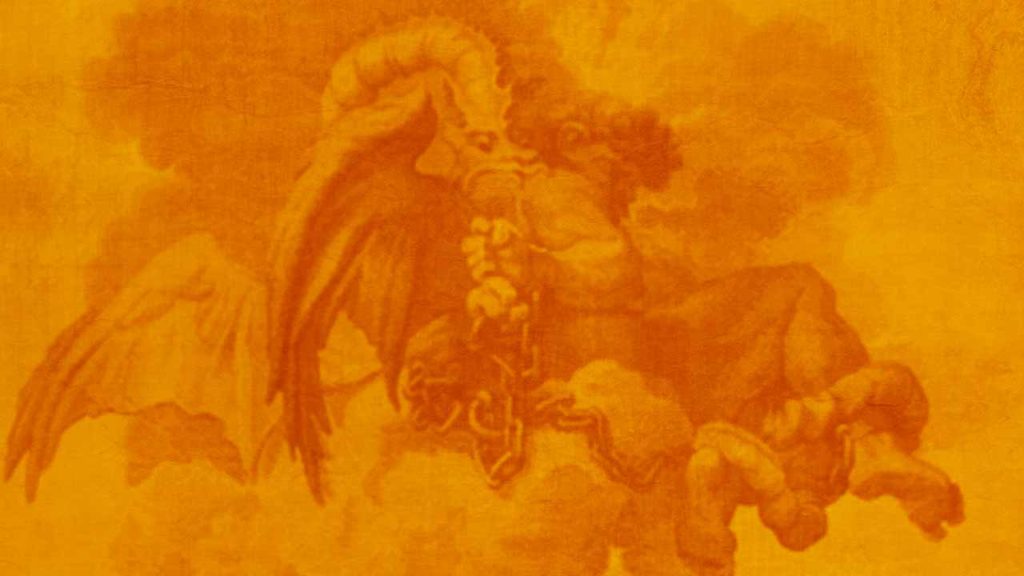

The books of 2 Peter and Jude in the New Testament add a layer of corroboration to the connection between the “sons of God” and angels.
For if God did not spare angels when they sinned, but cast them into hell [Greek: Tartarus] and committed them to chains of gloomy darkness to be kept until the judgment;
if he did not spare the ancient world, but preserved Noah, a herald of righteousness, with seven others, when he brought a flood upon the world of the ungodly;
2 Peter 2:4-5 (ESV)
Both passages make clear references and employ the same terminology found in the non-canonical “Book of Enoch” when describing a pre-flood angelic transgression, one that shared uncanny parallels with the sins of Sodom and Gomorrah.
And the angels who did not stay within their own position of authority, but left their proper dwelling, he has kept in eternal chains under gloomy darkness until the judgment of the great day – just as Sodom and Gomorrah and the surrounding cities, which likewise indulged in sexual immorality and pursued unnatural desire.
It was also about these that Enoch, the seventh from Adam, prophesied, saying, “Behold, the Lord comes with ten thousands of his holy ones, to execute judgment on all and to convict all the ungodly of all their deeds of ungodliness that they have committed in such an ungodly way, and of all the harsh things that ungodly sinners have spoken against him.”
Jude: 6-7, 14-15
Furthermore, the Book of Jude not only references the Book of Enoch but quotes it word for word, underscoring that the stories and interpretations contained within these texts were widely known during this period.
Josephus on the ‘sons of God’


Around 93 AD, Josephus, in his historical writings, provided a concise yet unambiguous understanding of the “sons of God” in Genesis 6. Josephus asserted, “For many angels of God accompanied with women and begat sons that proved unjust and despisers of all that was good, on account of the confidence they had in their own strength; for the tradition is that these men did what resembled the acts of those whom the Grecians call giants.”
For many angels of God accompanied with women, and begat sons that proved unjust, and despisers of all that was good, on account of the confidence they had in their own strength; for the tradition is, that these men did what resembled the acts of those whom the Grecians call giants.
Antiquities of the Jews, CHAPTER 3
While the Book of Enoch played a pivotal role in expounding the narrative of the “sons of God,” it’s important to note that not all historians and writers of the time delved as deeply into these accounts. This suggests that not all Jewish sects during that era regarded the relatively recent books of Enoch as entirely trustworthy.
What we can deduce from the historical record is based on those who did speak about it, and, for the most part, they were in agreement that the “sons of God” were direct creations of God, specifically angels.
The prevailing consensus during the first century was that the Genesis account was not just a biblical tale but a foundational narrative, one that influenced and connected with various legends and myths across different cultures.
How did the Early Church Fathers understand the ‘sons of God’? (100 AD to 300 AD)


In the earliest centuries of the Christian church, the interpretation of the “sons of God” in Genesis 6 as angelic beings was far from controversial.
In fact, it was a widely accepted and commonly understood belief among early church fathers and writers. Seventeen different church fathers and early church figures of this era retell the account, consistently identifying the “sons of God” as angels.
They seamlessly incorporated this interpretation into the broader narrative of the Antediluvian history without the need for extensive commentary. It was a prevailing consensus, reflecting an understanding rooted in the traditions of their time.
Let’s look at three of the earliest church fathers and see what they said.
Justin Martyr and the ‘angels captivated by the love of women’


Justin Martyr, who lived from 100 to 165 AD, was a prominent Christian apologist and theologian of the second century.
Ultimately martyred, Justin Martyr held a distinct view that the “sons of God” mentioned in Genesis 6:1-4 referred to angelic beings. His interpretation seemed to be influenced by the Book of Enoch. Much like Philo and Josephus, Justin believed that many pagan myths had their origins in this biblical account.
But the angels transgressed this appointment, and were captivated by love of women, and begot children who are those that are called demons; and besides, they afterwards subdued the human race to themselves…
Whence also the poets and mythologists, not knowing that it was the angels and those demons who had been begotten by them that did these things to men, and women, and cities, and nations, which they related, ascribed them to god himself, and to those who were accounted to be his very offspring.
Justin Martyr
Irenaeus of Lyons: Clear Influence from the Book of Enoch
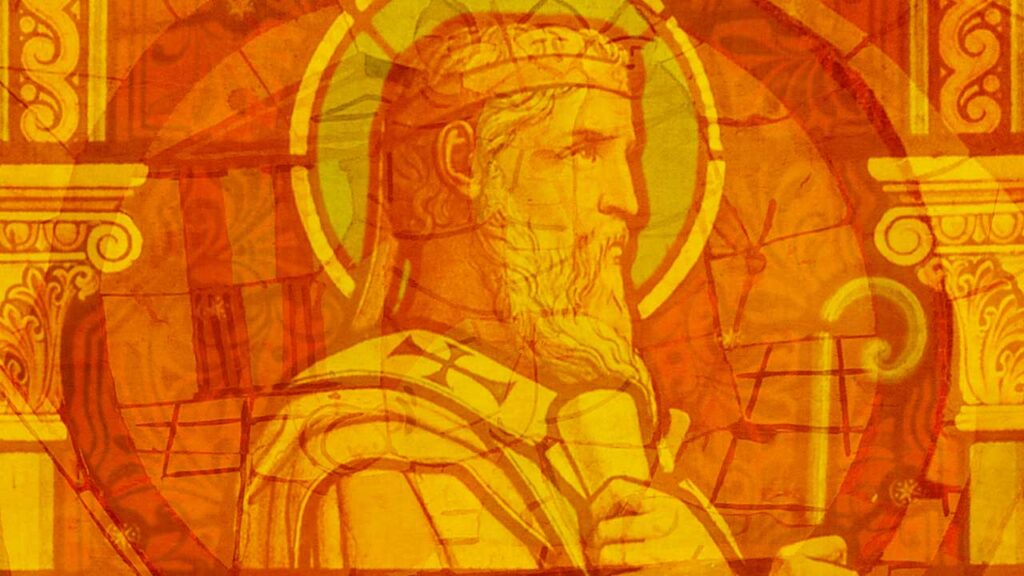

Irenaeus of Lyons, dating from 130 to 202 AD, was a Christian bishop and theologian of the second century. He was a disciple of Polycarp, who, in turn, had been a disciple of John the Apostle. Irenaeus had a profound impact on the development of Christian theology.
In his work “Against Heresies,” he emphasized the unity of God and the centrality of the apostles’ teachings. Irenaeus firmly believed that the “sons of God” in Genesis 6:1-4 were indeed angelic beings. According to his interpretation, their union with human women resulted in the infamous Nephilim or Giants.
Irenaeus’s understanding seemed to be influenced by the narrative found in the Book of Enoch, because later in the passage he attributes certain knowledge such as the invention of cosmetics as coming from the angels.
Illicit unions took place upon the earth, since angels were united with the daughters of the race of mankind; and they bore to them sons who for their exceeding greatness were called giants.
Irenaeus of Lyons
Tertullian on the ‘sons of God’


Tertullian, who lived from 160 to 225 AD, expressed an intriguing perspective on the “sons of God.” He proposed that those angels who had deserted God, becoming captivated by their love for women, were not only responsible for their transgression but were also the discoverers of curious arts.
This viewpoint emphasized the connection between the fallen angels and the introduction of forbidden knowledge. Tertullian saw their actions as both a betrayal of God and an introduction of forbidden practices, echoing the thematic elements found in the Genesis account.
The Angelic interpretation was not just an isolated perspective; it was a widely accepted and unifying belief among early Christian scholars and writers. However, it’s distasteful implications began to cause others to look for less outrageous and more palatable explanations.
Augustine to the Reformation (300AD – Reformation)
As we progress through the centuries, the interpretation of the “sons of God” in Genesis 6 begins to exhibit some shifts in perspective, with notable figures like Augustine and Julius Africanus introducing nuanced views that differ from the previously established consensus.
It is essential to appreciate the complexity of these discussions rather than simplifying them into a rigid binary between angelic and human interpretation.
Julius Africanus Suggests a New Interpretation


Julius Africanus, living between 160 and 240 AD, made a contribution to the evolving discourse surrounding the “sons of God.” He proposed a view that departed from the prevailing belief that these sons were angelic beings. Africanus suggested that the “sons of God” were, in fact, the descendants of Seth, rather than supernatural entities.
In his own words, he explains,
In some copies I found ‘the sons of God.’ What is meant by the Spirit, in my opinion, is that the descendants of Seth are called the sons of God on account of the righteous men and patriarchs who have sprung from him, even down to the Saviour Himself.
Julius Africanus
He posited that the offspring of Cain were termed the “seed of men,” representing a race tainted by wickedness and lacking divine connection. Africanus did acknowledge the possibility that the “sons of God” might refer to angels who engaged in questionable practices, leading to the birth of giants and the proliferation of wickedness.
It is evident that he did not outright dismiss the angelic interpretation but explored the idea of the Sethite lineage as an alternative perspective.
Augustine on the ‘sons of God’: Not a Slam Dunk\
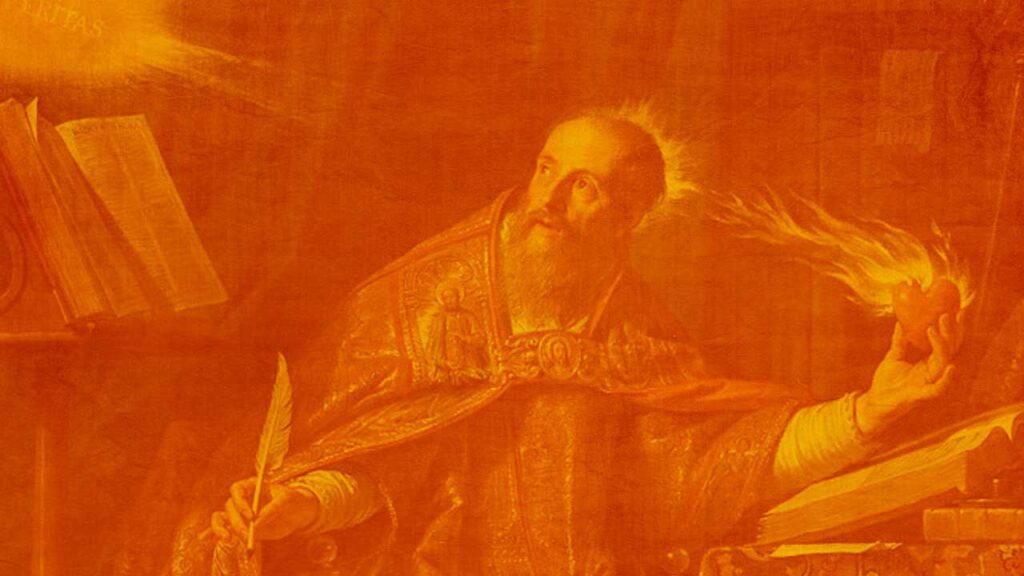

Augustine, a prominent theologian and philosopher who lived from 354 to 430 AD, delved into the same topic in his work, “The City of God, Volume 1.” Augustine initiated his exploration by drawing a parallel between the mythical accounts of Greco-Roman gods having relations with mortals and the biblical narrative of the Nephilim. He presented examples such as Venus bearing Æneas to Anchises and Mars begetting Romulus with the daughter of Numitor.
Augustine considered these stories as unsettled questions. He stated,
But whether Venus could bear Æneas to a human father Anchises, or Mars beget Romulus of the daughter of Numitor, we leave as unsettled questions. For our own Scriptures suggest the very similar question, whether the fallen angels had sexual intercourse with the daughters of men, by which the earth was at that time filled with giants, that is, with enormously large and strong men.
It is therefore more credible that righteous men, called angels, or sons of God, moved by lust, sinned with women, instead of angels, who could not commit that sin because they lack bodies; although certain demons have been evil with women, so many things are said and by so many people, that it is not easy to decide on an opinion on this question.
Augustine of Hippo
Augustine’s approach, while acknowledging the possibility of an angelic interpretation, underscored the complexities of the matter and the absence of a clear answer.
During this period, the interpretation of the “sons of God” as angels persisted among some writers, including Sulpicius Severus, Jerome, and Ambrose of Milan.
However, a shift toward the “Sethite” perspective was also noticeable, with figures like Athanasius of Alexandria, John Cassian, and John Chrysostom adopting this alternative view.
The Reformers on the ‘sons of God’
John Calvin, the father of Reformed theology, firmly rejected the traditional idea that the “sons of God” were angels. He found this notion to be absurd and questioned how learned individuals had ever entertained such fantastical ideas.
Martin Luther provided a distinctive perspective, identifying the “sons of God” as those who held the promise of the “blessed Seed” and constituted the “true church.” He disagreed with the angelic interpretation and suggested that they were believers recognizing God as their Father, although he did not explicitly mention Seth, his description pointed to Seth’s descendants as the people with the promise of the “blessed seed.”
Modern Christian Thought (21st Century)
As the centuries rolled on, influential theologians like Augustine, John Calvin, and Martin Luther played significant roles in shaping the interpretation of the Genesis 6 passage.
However, the modern era brought with it new perspectives and challenges that have reinvigorated the discussion about the “sons of God.”
One of the pivotal moments in this ongoing debate was the reappearance of the Book of Enoch in the 1800s, which, though not discussed in detail in this article, significantly impacted modern discussions on this topic.
However, an even more substantial development occurred in the 20th century with the discovery of several ancient texts among the Dead Sea Scrolls. These ancient writings included several books (the Book of Enoch among them) discussing the angelic origin of the “sons of God” and demonstrating that these ideas predated Christ, reaching back at least to the 2nd century BC.



For modern theologians, this discovery proved to be a turning point, reigniting interest in solving this mystery.
In contemporary Christian thought, theologians and pastors are split, with a rising number adopting the ‘angelic’ view due to its antiquity, textual support and obvious parrells in ancient myth.
Dr. Michael Heiser on the ‘sons of God’


The late Dr. Michael Heiser, a well-known figure in the field of biblical research, has been instrumental in investigating and debunking topics often overlooked by traditional scholars. He unequivocally states,
…the ‘sons of God’ are supernatural beings. They are not people. That’s probably the shortest way to answer that… They were members of the heavenly host who transgressed the boundaries of heaven and earth with disastrous effects.
Dr. Michael Heiser
Listen to his explanation starting at 14:49 in the video below.
Tim Mackie from The Bible Project on the ‘sons of God’


Another prominent voice in modern Christian thought is Tim Mackie, one of the co-founders of The Bible Project, known for its educational videos, podcasts, and online courses.
In his perspective on Genesis 6:1-4, he sees little room for debate, stating,
So remember the concept of God’s heavenly staff team, the divine council, or the sons of God? In the Hebrew Scriptures, we’re told that some of these rebelled too.
After the snake comes the rebellion of the sons of God in Genesis 6. We’re told that they have sex with women who then give birth to violent warrior giants.
Ancient readers knew exactly what was going on. The ancient kingdoms around Israel claimed to be founded and protected by giant warrior kings who were part human, part god and filled with divine wisdom.
Tim Mackie – The Bible Project
Al Mohler on the ‘sons of God’


Al Mohler, president of the Southern Baptist Theological Seminary and a leading figure in evangelical Christianity, interprets Genesis 6:1-4 as referring to angelic beings with free will who sinned by cohabiting with women, resulting in the Nephilim.
According to Mohler, this view is affirmed in the New Testament in the book of Jude, verses 6-7.
Ken Ham Prefers the Sethite Interpretation


However, some, like Ken Ham from Answers in Genesis, continue to prefer the Sethite view.
Ham simplifies the interpretation by suggesting that the “sons of God” refer to the godly line of Seth, who began marrying the ungodly line of Cain, leading to the destruction of families through the mixing of spiritual light and darkness.
Modern Research into the Identity of the ‘Sons of God’
Modern research, conducted by both secular and religious scholars, has significantly enriched the ongoing discourse on the identity of the “sons of God” in Genesis 6.
Several papers and studies have contributed to this discussion.


One notable example is Amar Annus, a scholar hailing from the University of Tartu in Estonia.
In his 2010 paper published in the Journal for the Study of The Pseudepigrapha, Annus delves into the intriguing link between the Enochian “Watchers” and the ‘apkallus,’ antediluvian sages in Mesopotamian mythology. He makes a compelling argument:
The ‘sons of God’ in Genesis and the Watchers in Enochic literature are fully divine, as also were the antediluvian apkallus in the Mesopotamian tradition. The four post-flood apkallus were ‘of human descent,’ which means that apkallus could mate with humans, as the Watchers did.
Amar Annus
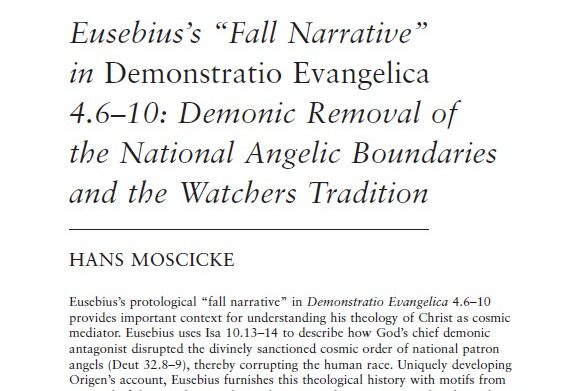

Hans M. Moscicke, a PhD candidate at Marquette University, offers another perspective.
In his 2018 research, Moscicke explores how Eusebius viewed the fall and Christ as a ‘cosmic mediator,’ uncovering threads of the traditional Enochian Watcher narrative woven into the Christology of Eusebius.
Moscicke’s findings emphasize the enduring influence of Jewish apocalyptic currents, such as the Enochic Watchers myth and the patron angel tradition, on the theology of mainstream Christian theologians, even in the early fourth century.
These are just a couple of examples of the diverse and engaging research that has contributed to the ongoing discussion surrounding the “sons of God” in Genesis 6. A plethora of research papers, each examining various aspects of this intriguing topic, can be found in our database of nephilim research papers, providing valuable insights from scholars worldwide.
The ‘sons of God’ contrasted with ‘THE Son of God’
While several perspectives have been proposed, the notion that the “sons of God” were fallen angels remains the interpretation with substantial support, backed by textual, historical, and theological reasoning.
From a theological perspective, interpreting the “sons of God” as angels highlights the gravity of their transgression and underscores the mingling of the supernatural with the earthly.
This interpretation reveals an angelic incarnation that ultimately failed, offering a stark contrast to the appearance of Jesus, the only begotten Son of God. Unlike the “sons of God,” Jesus resisted temptation, followed His Father’s will, and laid down His life for the redemption of humanity.
In summary, the identification of the “sons of God” as fallen angels in Genesis 6 stands as the interpretation with the strongest support from textual, historical, and theological angles.
As we continue to explore this ancient mystery, it leads us to contemplate the ultimate contrast: the appearance of Jesus, the sinless Son of God, who fulfilled His divine mission and offered salvation to all of humanity.
Learn more about the Nephilim and Genesis 6
To delve further into the realm of the Nephilim and the “sons of God,” we invite you to explore resources and articles available at chasingthegiants.com.
Amid the vast sea of online information, our platform is dedicated to providing access to well-researched materials, guiding you on a journey to uncover the secrets concealed within the pages of Genesis 6.

